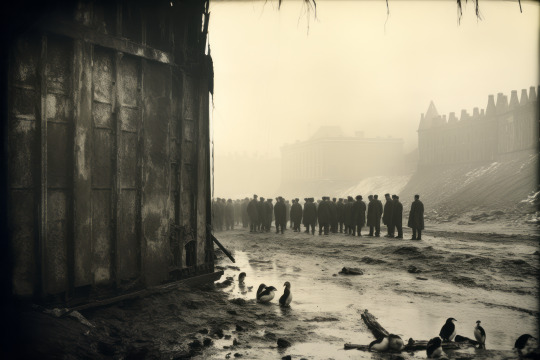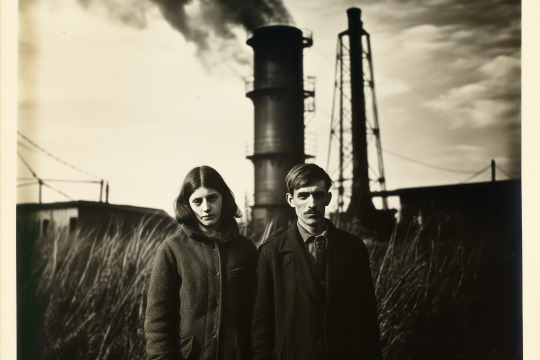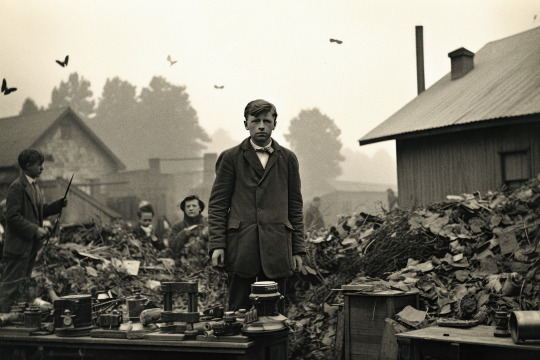Text

Collective memories X, 13
The term "collective memory" denotes the aggregate of memories, knowledge, and data that a social group holds, which is intrinsically linked to the group's identity. The term "collective memory" in English and its French counterpart "la mémoire collective" emerged in the latter half of the 19th century. Maurice Halbwachs, a philosopher and sociologist, further developed this concept in his 1925 work, «Les cadres sociaux de la mémoire». Both expansive and intimate social collectives can create, disseminate, and inherit collective memory.
Contrary to the term "collective memory," which is somewhat ambiguously defined yet generally accepted, the notion of "collective memories" is inherently problematic. Memories are the results of the individual acts of recollection, making the idea of "collective memories" paradoxical. Сontemporary diffusion models utilize vast amounts of often unidentified data, including historical and personal old photographs, vintage postcards, and other kinds of publicly circulating images. These models may be seen as involved in the prompts-driven singular acts of remembrance, producing images that paradoxically represent "collective memories," something otherwise unfeasible and ultimately, non-existent.
#AI#generative art#ai art#Midjourney#neurophotography#promptography#collective memories#vintage style#retro style#neuroart#generative Kunst#KI-Kunst#kollektive Erinnerungen#Vintage-Stil#arte generativo#arte de IA#生成的#生成艺术#人工智能艺术#集体
4 notes
·
View notes
Text

Collective memories X, 12
The term "collective memory" denotes the aggregate of memories, knowledge, and data that a social group holds, which is intrinsically linked to the group's identity. The term "collective memory" in English and its French counterpart "la mémoire collective" emerged in the latter half of the 19th century. Maurice Halbwachs, a philosopher and sociologist, further developed this concept in his 1925 work, «Les cadres sociaux de la mémoire». Both expansive and intimate social collectives can create, disseminate, and inherit collective memory.
Contrary to the term "collective memory," which is somewhat ambiguously defined yet generally accepted, the notion of "collective memories" is inherently problematic. Memories are the results of the individual acts of recollection, making the idea of "collective memories" paradoxical. Сontemporary diffusion models utilize vast amounts of often unidentified data, including historical and personal old photographs, vintage postcards, and other kinds of publicly circulating images. These models may be seen as involved in the prompts-driven singular acts of remembrance, producing images that paradoxically represent "collective memories," something otherwise unfeasible and ultimately, non-existent.
#AI#generative art#ai art#Midjourney#neurophotography#promptography#collective memories#vintage style#retro style#neuroart#generative Kunst#KI-Kunst#kollektive Erinnerungen#Vintage-Stil#arte generativo#arte de IA#生成的#生成艺术#人工智能艺术#集体
1 note
·
View note
Text

Collective memories X, 11
The term "collective memory" denotes the aggregate of memories, knowledge, and data that a social group holds, which is intrinsically linked to the group's identity. The term "collective memory" in English and its French counterpart "la mémoire collective" emerged in the latter half of the 19th century. Maurice Halbwachs, a philosopher and sociologist, further developed this concept in his 1925 work, «Les cadres sociaux de la mémoire». Both expansive and intimate social collectives can create, disseminate, and inherit collective memory.
Contrary to the term "collective memory," which is somewhat ambiguously defined yet generally accepted, the notion of "collective memories" is inherently problematic. Memories are the results of the individual acts of recollection, making the idea of "collective memories" paradoxical. Сontemporary diffusion models utilize vast amounts of often unidentified data, including historical and personal old photographs, vintage postcards, and other kinds of publicly circulating images. These models may be seen as involved in the prompts-driven singular acts of remembrance, producing images that paradoxically represent "collective memories," something otherwise unfeasible and ultimately, non-existent.
#AI#generative art#ai art#Midjourney#neurophotography#promptography#collective memories#vintage style#retro style#neuroart#generative Kunst#KI-Kunst#kollektive Erinnerungen#Vintage-Stil#arte generativo#arte de IA#生成的#生成艺术#人工智能艺术#集体
2 notes
·
View notes
Text

Collective memories X, 10
The term "collective memory" denotes the aggregate of memories, knowledge, and data that a social group holds, which is intrinsically linked to the group's identity. The term "collective memory" in English and its French counterpart "la mémoire collective" emerged in the latter half of the 19th century. Maurice Halbwachs, a philosopher and sociologist, further developed this concept in his 1925 work, «Les cadres sociaux de la mémoire». Both expansive and intimate social collectives can create, disseminate, and inherit collective memory.
Contrary to the term "collective memory," which is somewhat ambiguously defined yet generally accepted, the notion of "collective memories" is inherently problematic. Memories are the results of the individual acts of recollection, making the idea of "collective memories" paradoxical. Сontemporary diffusion models utilize vast amounts of often unidentified data, including historical and personal old photographs, vintage postcards, and other kinds of publicly circulating images. These models may be seen as involved in the prompts-driven singular acts of remembrance, producing images that paradoxically represent "collective memories," something otherwise unfeasible and ultimately, non-existent.
#AI#generative art#ai art#Midjourney#neurophotography#promptography#collective memories#vintage style#retro style#neuroart#generative Kunst#KI-Kunst#kollektive Erinnerungen#Vintage-Stil#arte generativo#arte de IA#生成的#生成艺术#人工智能艺术#集体
4 notes
·
View notes
Text

Collective memories X, 09
The term "collective memory" denotes the aggregate of memories, knowledge, and data that a social group holds, which is intrinsically linked to the group's identity. The term "collective memory" in English and its French counterpart "la mémoire collective" emerged in the latter half of the 19th century. Maurice Halbwachs, a philosopher and sociologist, further developed this concept in his 1925 work, «Les cadres sociaux de la mémoire». Both expansive and intimate social collectives can create, disseminate, and inherit collective memory.
Contrary to the term "collective memory," which is somewhat ambiguously defined yet generally accepted, the notion of "collective memories" is inherently problematic. Memories are the results of the individual acts of recollection, making the idea of "collective memories" paradoxical. Сontemporary diffusion models utilize vast amounts of often unidentified data, including historical and personal old photographs, vintage postcards, and other kinds of publicly circulating images. These models may be seen as involved in the prompts-driven singular acts of remembrance, producing images that paradoxically represent "collective memories," something otherwise unfeasible and ultimately, non-existent.
#AI#generative art#ai art#Midjourney#neurophotography#promptography#collective memories#vintage style#retro style#neuroart#generative Kunst#KI-Kunst#kollektive Erinnerungen#Vintage-Stil#arte generativo#arte de IA#生成的#生成艺术#人工智能艺术#集体
2 notes
·
View notes
Text

Collective memories X, 08
The term "collective memory" denotes the aggregate of memories, knowledge, and data that a social group holds, which is intrinsically linked to the group's identity. The term "collective memory" in English and its French counterpart "la mémoire collective" emerged in the latter half of the 19th century. Maurice Halbwachs, a philosopher and sociologist, further developed this concept in his 1925 work, «Les cadres sociaux de la mémoire». Both expansive and intimate social collectives can create, disseminate, and inherit collective memory.
Contrary to the term "collective memory," which is somewhat ambiguously defined yet generally accepted, the notion of "collective memories" is inherently problematic. Memories are the results of the individual acts of recollection, making the idea of "collective memories" paradoxical. Сontemporary diffusion models utilize vast amounts of often unidentified data, including historical and personal old photographs, vintage postcards, and other kinds of publicly circulating images. These models may be seen as involved in the prompts-driven singular acts of remembrance, producing images that paradoxically represent "collective memories," something otherwise unfeasible and ultimately, non-existent.
#AI#generative art#ai art#Midjourney#neurophotography#promptography#collective memories#vintage style#retro style#neuroart#generative Kunst#KI-Kunst#kollektive Erinnerungen#Vintage-Stil#arte generativo#arte de IA#生成的#生成艺术#人工智能艺术#集体
1 note
·
View note
Text

Collective memories X, 07
The term "collective memory" denotes the aggregate of memories, knowledge, and data that a social group holds, which is intrinsically linked to the group's identity. The term "collective memory" in English and its French counterpart "la mémoire collective" emerged in the latter half of the 19th century. Maurice Halbwachs, a philosopher and sociologist, further developed this concept in his 1925 work, «Les cadres sociaux de la mémoire». Both expansive and intimate social collectives can create, disseminate, and inherit collective memory.
Contrary to the term "collective memory," which is somewhat ambiguously defined yet generally accepted, the notion of "collective memories" is inherently problematic. Memories are the results of the individual acts of recollection, making the idea of "collective memories" paradoxical. Сontemporary diffusion models utilize vast amounts of often unidentified data, including historical and personal old photographs, vintage postcards, and other kinds of publicly circulating images. These models may be seen as involved in the prompts-driven singular acts of remembrance, producing images that paradoxically represent "collective memories," something otherwise unfeasible and ultimately, non-existent.
#AI#generative art#ai art#Midjourney#neurophotography#promptography#collective memories#vintage style#retro style#neuroart#generative Kunst#KI-Kunst#kollektive Erinnerungen#Vintage-Stil#arte generativo#arte de IA#生成的#生成艺术#人工智能艺术#集体
3 notes
·
View notes
Text

Collective memories X, 06
The term "collective memory" denotes the aggregate of memories, knowledge, and data that a social group holds, which is intrinsically linked to the group's identity. The term "collective memory" in English and its French counterpart "la mémoire collective" emerged in the latter half of the 19th century. Maurice Halbwachs, a philosopher and sociologist, further developed this concept in his 1925 work, «Les cadres sociaux de la mémoire». Both expansive and intimate social collectives can create, disseminate, and inherit collective memory.
Contrary to the term "collective memory," which is somewhat ambiguously defined yet generally accepted, the notion of "collective memories" is inherently problematic. Memories are the results of the individual acts of recollection, making the idea of "collective memories" paradoxical. Сontemporary diffusion models utilize vast amounts of often unidentified data, including historical and personal old photographs, vintage postcards, and other kinds of publicly circulating images. These models may be seen as involved in the prompts-driven singular acts of remembrance, producing images that paradoxically represent "collective memories," something otherwise unfeasible and ultimately, non-existent.
#AI#generative art#ai art#Midjourney#neurophotography#promptography#collective memories#vintage style#retro style#neuroart#generative Kunst#KI-Kunst#kollektive Erinnerungen#Vintage-Stil#arte generativo#arte de IA#生成的#生成艺术#人工智能艺术#集体
5 notes
·
View notes
Text

Collective memories X, 05
The term "collective memory" denotes the aggregate of memories, knowledge, and data that a social group holds, which is intrinsically linked to the group's identity. The term "collective memory" in English and its French counterpart "la mémoire collective" emerged in the latter half of the 19th century. Maurice Halbwachs, a philosopher and sociologist, further developed this concept in his 1925 work, «Les cadres sociaux de la mémoire». Both expansive and intimate social collectives can create, disseminate, and inherit collective memory.
Contrary to the term "collective memory," which is somewhat ambiguously defined yet generally accepted, the notion of "collective memories" is inherently problematic. Memories are the results of the individual acts of recollection, making the idea of "collective memories" paradoxical. Сontemporary diffusion models utilize vast amounts of often unidentified data, including historical and personal old photographs, vintage postcards, and other kinds of publicly circulating images. These models may be seen as involved in the prompts-driven singular acts of remembrance, producing images that paradoxically represent "collective memories," something otherwise unfeasible and ultimately, non-existent.
#AI#generative art#ai art#Midjourney#neurophotography#promptography#collective memories#vintage style#retro style#neuroart#generative Kunst#KI-Kunst#kollektive Erinnerungen#Vintage-Stil#arte generativo#arte de IA#生成的#生成艺术#人工智能艺术#集体
5 notes
·
View notes
Text

Collective memories X, 04
The term "collective memory" denotes the aggregate of memories, knowledge, and data that a social group holds, which is intrinsically linked to the group's identity. The term "collective memory" in English and its French counterpart "la mémoire collective" emerged in the latter half of the 19th century. Maurice Halbwachs, a philosopher and sociologist, further developed this concept in his 1925 work, «Les cadres sociaux de la mémoire». Both expansive and intimate social collectives can create, disseminate, and inherit collective memory.
Contrary to the term "collective memory," which is somewhat ambiguously defined yet generally accepted, the notion of "collective memories" is inherently problematic. Memories are the results of the individual acts of recollection, making the idea of "collective memories" paradoxical. Сontemporary diffusion models utilize vast amounts of often unidentified data, including historical and personal old photographs, vintage postcards, and other kinds of publicly circulating images. These models may be seen as involved in the prompts-driven singular acts of remembrance, producing images that paradoxically represent "collective memories," something otherwise unfeasible and ultimately, non-existent.
#AI#generative art#ai art#Midjourney#neurophotography#promptography#collective memories#vintage style#retro style#neuroart#generative Kunst#KI-Kunst#kollektive Erinnerungen#Vintage-Stil#arte generativo#arte de IA#生成的#生成艺术#人工智能艺术#集体
6 notes
·
View notes
Text

Collective memories X, 03
The term "collective memory" denotes the aggregate of memories, knowledge, and data that a social group holds, which is intrinsically linked to the group's identity. The term "collective memory" in English and its French counterpart "la mémoire collective" emerged in the latter half of the 19th century. Maurice Halbwachs, a philosopher and sociologist, further developed this concept in his 1925 work, «Les cadres sociaux de la mémoire». Both expansive and intimate social collectives can create, disseminate, and inherit collective memory.
Contrary to the term "collective memory," which is somewhat ambiguously defined yet generally accepted, the notion of "collective memories" is inherently problematic. Memories are the results of the individual acts of recollection, making the idea of "collective memories" paradoxical. Сontemporary diffusion models utilize vast amounts of often unidentified data, including historical and personal old photographs, vintage postcards, and other kinds of publicly circulating images. These models may be seen as involved in the prompts-driven singular acts of remembrance, producing images that paradoxically represent "collective memories," something otherwise unfeasible and ultimately, non-existent.
#AI#generative art#ai art#Midjourney#neurophotography#promptography#collective memories#vintage style#retro style#neuroart#generative Kunst#KI-Kunst#kollektive Erinnerungen#Vintage-Stil#arte generativo#arte de IA#生成的#生成艺术#人工智能艺术#集体
1 note
·
View note
Text

Collective memories X, 02
The term "collective memory" denotes the aggregate of memories, knowledge, and data that a social group holds, which is intrinsically linked to the group's identity. The term "collective memory" in English and its French counterpart "la mémoire collective" emerged in the latter half of the 19th century. Maurice Halbwachs, a philosopher and sociologist, further developed this concept in his 1925 work, «Les cadres sociaux de la mémoire». Both expansive and intimate social collectives can create, disseminate, and inherit collective memory.
Contrary to the term "collective memory," which is somewhat ambiguously defined yet generally accepted, the notion of "collective memories" is inherently problematic. Memories are the results of the individual acts of recollection, making the idea of "collective memories" paradoxical. Сontemporary diffusion models utilize vast amounts of often unidentified data, including historical and personal old photographs, vintage postcards, and other kinds of publicly circulating images. These models may be seen as involved in the prompts-driven singular acts of remembrance, producing images that paradoxically represent "collective memories," something otherwise unfeasible and ultimately, non-existent.
#AI#generative art#ai art#Midjourney#neurophotography#promptography#collective memories#vintage style#retro style#neuroart#generative Kunst#KI-Kunst#kollektive Erinnerungen#Vintage-Stil#arte generativo#arte de IA#生成的#生成艺术#人工智能艺术#集体
7 notes
·
View notes
Text

Collective memories X, 01
The term "collective memory" denotes the aggregate of memories, knowledge, and data that a social group holds, which is intrinsically linked to the group's identity. The term "collective memory" in English and its French counterpart "la mémoire collective" emerged in the latter half of the 19th century. Maurice Halbwachs, a philosopher and sociologist, further developed this concept in his 1925 work, «Les cadres sociaux de la mémoire». Both expansive and intimate social collectives can create, disseminate, and inherit collective memory.
Contrary to the term "collective memory," which is somewhat ambiguously defined yet generally accepted, the notion of "collective memories" is inherently problematic. Memories are the results of the individual acts of recollection, making the idea of "collective memories" paradoxical. Сontemporary diffusion models utilize vast amounts of often unidentified data, including historical and personal old photographs, vintage postcards, and other kinds of publicly circulating images. These models may be seen as involved in the prompts-driven singular acts of remembrance, producing images that paradoxically represent "collective memories," something otherwise unfeasible and ultimately, non-existent.
#AI#generative art#ai art#Midjourney#neurophotography#promptography#collective memories#vintage style#retro style#neuroart#generative Kunst#KI-Kunst#kollektive Erinnerungen#Vintage-Stil#arte generativo#arte de IA#生成的#生成艺术#人工智能艺术#集体
2 notes
·
View notes
Text

Now, here's some advertising for you. I've decided to give it a try and now you can buy some prints on FY! The choice there is somewhat different (for obvious reasons) from what you normally see here. Still, I wold be grateful if you find 5 minutes to visit the shop and
buy one of these or some other image as print on FY!
If there's a particular image from this Tumblr you're willing to buy there, it can be organized, just write me a personal message with a link to the image.
Thanks!
56 notes
·
View notes
Text

Collective memories IX, 13
The term "collective memory" denotes the aggregate of memories, knowledge, and data that a social group holds, which is intrinsically linked to the group's identity. The term "collective memory" in English and its French counterpart "la mémoire collective" emerged in the latter half of the 19th century. Maurice Halbwachs, a philosopher and sociologist, further developed this concept in his 1925 work, «Les cadres sociaux de la mémoire». Both expansive and intimate social collectives can create, disseminate, and inherit collective memory.
Contrary to the term "collective memory," which is somewhat ambiguously defined yet generally accepted, the notion of "collective memories" is inherently problematic. Memories are the results of the individual acts of recollection, making the idea of "collective memories" paradoxical. Сontemporary diffusion models utilize vast amounts of often unidentified data, including historical and personal old photographs, vintage postcards, and other kinds of publicly circulating images. These models may be seen as involved in the prompts-driven singular acts of remembrance, producing images that paradoxically represent "collective memories," something otherwise unfeasible and ultimately, non-existent.
#AI#generative art#ai art#Midjourney#neurophotography#promptography#collective memories#vintage style#retro style#neuroart#generative Kunst#KI-Kunst#kollektive Erinnerungen#Vintage-Stil#arte generativo#arte de IA#生成的#生成艺术#人工智能艺术#集体
3 notes
·
View notes
Text

Collective memories IX, 12
The term "collective memory" denotes the aggregate of memories, knowledge, and data that a social group holds, which is intrinsically linked to the group's identity. The term "collective memory" in English and its French counterpart "la mémoire collective" emerged in the latter half of the 19th century. Maurice Halbwachs, a philosopher and sociologist, further developed this concept in his 1925 work, «Les cadres sociaux de la mémoire». Both expansive and intimate social collectives can create, disseminate, and inherit collective memory.
Contrary to the term "collective memory," which is somewhat ambiguously defined yet generally accepted, the notion of "collective memories" is inherently problematic. Memories are the results of the individual acts of recollection, making the idea of "collective memories" paradoxical. Сontemporary diffusion models utilize vast amounts of often unidentified data, including historical and personal old photographs, vintage postcards, and other kinds of publicly circulating images. These models may be seen as involved in the prompts-driven singular acts of remembrance, producing images that paradoxically represent "collective memories," something otherwise unfeasible and ultimately, non-existent.
#AI#generative art#ai art#Midjourney#neurophotography#promptography#collective memories#vintage style#retro style#neuroart#generative Kunst#KI-Kunst#kollektive Erinnerungen#Vintage-Stil#arte generativo#arte de IA#生成的#生成艺术#人工智能艺术#集体
0 notes
Text

Collective memories IX, 11
The term "collective memory" denotes the aggregate of memories, knowledge, and data that a social group holds, which is intrinsically linked to the group's identity. The term "collective memory" in English and its French counterpart "la mémoire collective" emerged in the latter half of the 19th century. Maurice Halbwachs, a philosopher and sociologist, further developed this concept in his 1925 work, «Les cadres sociaux de la mémoire». Both expansive and intimate social collectives can create, disseminate, and inherit collective memory.
Contrary to the term "collective memory," which is somewhat ambiguously defined yet generally accepted, the notion of "collective memories" is inherently problematic. Memories are the results of the individual acts of recollection, making the idea of "collective memories" paradoxical. Сontemporary diffusion models utilize vast amounts of often unidentified data, including historical and personal old photographs, vintage postcards, and other kinds of publicly circulating images. These models may be seen as involved in the prompts-driven singular acts of remembrance, producing images that paradoxically represent "collective memories," something otherwise unfeasible and ultimately, non-existent.
#AI#generative art#ai art#Midjourney#neurophotography#promptography#collective memories#vintage style#retro style#neuroart#generative Kunst#KI-Kunst#kollektive Erinnerungen#Vintage-Stil#arte generativo#arte de IA#生成的#生成艺术#人工智能艺术#集体
0 notes